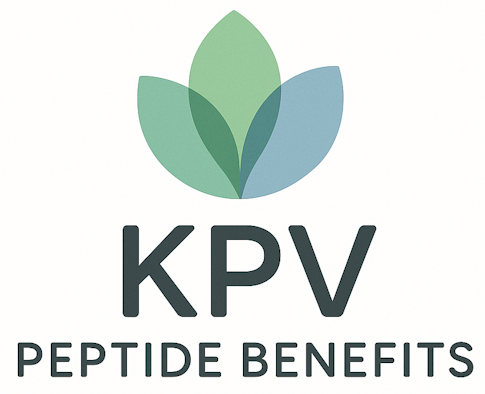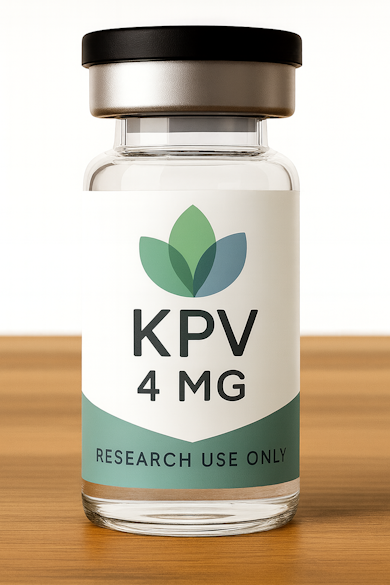Your cart is currently empty!
Buy KPV Peptide (4 MG)
Note: We are currently out of stock on this item. Click Here to pick up the KPV 4mg peptide from our partner, Core Peptides.
KPV Peptide (Lys-Pro-Val) is a potent α-MSH fragment shown to calm inflammation, strengthen barrier function, and promote tissue repair. Acting through NF-κB and PepT1 pathways, it supports cellular recovery, skin resilience, and balanced immune signaling—making it a powerful tool for advanced anti-inflammatory and regenerative research.
Description
What is KPV Peptide?
KPV is a short tripeptide composed of Lysine–Proline–Valine, corresponding to the C-terminal fragment of the hormone α-melanocyte stimulating hormone (α-MSH). This tiny sequence has been shown in preclinical research to retain much of α-MSH’s powerful anti-inflammatory and tissue-protective activity, with simpler chemistry and good stability in delivery systems. [1]
Studies in cell models and animal systems suggest that KPV:
- Acts as a targeted anti-inflammatory peptide in the gut, skin, and other barrier tissues. [1]
- Helps preserve and restore epithelial barrier function in models of colitis and intestinal injury. [2, 7]
- Supports wound healing and healthy tissue remodeling when incorporated into smart dressings and hydrogels. [7]
Important: KPV is an experimental research peptide. It is not an approved drug and is not intended to diagnose, treat, cure, or prevent any disease. All information below describes preclinical and mechanistic research, not established medical therapy.
Biochemistry & Mechanisms of Action
Core Biochemistry
- Structure: Tripeptide Lys-Pro-Val (KPV), derived from the 11–13 amino acids of α-MSH. [1]
- Transport: Efficiently taken up by PepT1, a proton-coupled di/tripeptide transporter highly expressed in small intestine and induced in inflamed colon and immune cells. [1, 2, 3]
- Receptor independence: In intestinal models, KPV’s anti-inflammatory effects appear largely independent of classical melanocortin receptors, instead relying on transport into cells via PepT1.[4, 5]
Anti-Inflammatory Signaling
Across multiple studies, KPV has been shown to:
- Inhibit NF-κB and MAPK activation, central hubs of inflammatory signaling, leading to reduced production of cytokines such as IL-1β, IL-6, TNF-α and IFN-γ. [4, 6]
- Reduce IL-8 and other chemokine release from intestinal epithelial and immune cells exposed to inflammatory stimuli. [8]
- In newer skin models, help block ROS-driven caspase-1 activation and downstream IL-1β secretion induced by particulate pollution (PM10). [9]
These mechanisms position KPV as a cell-penetrant regulator of inflammatory cascades, working upstream at key transcriptional nodes.
Key Research-Backed Benefits
-
Anti-Inflammatory Effects
In preclinical models, KPV has demonstrated robust anti-inflammatory activity:
- Experimental colitis: Orally delivered KPV reduced body-weight loss, colonic myeloperoxidase activity, histologic damage, and pro-inflammatory cytokine expression in DSS- and TNBS-induced colitis models in mice. [4, 5, 8]
- Colitis-associated cancer: KPV, transported into cells via PepT1, helped prevent colitis-associated carcinogenesis in mouse models; this effect disappeared when PepT1 was absent, highlighting a transporter-dependent mechanism.
- Broad melanocortin axis: Reviews of α-MSH and related peptides note that many of the anti-inflammatory actions can be attributed specifically to the KPV fragment, confirming its central role among melanocortin-derived peptides. [11, 12]
-
Tissue Repair & Barrier Integrity
KPV has been incorporated into advanced delivery systems to support tissue repair and mucosal healing:
- Hyaluronic acid–KPV nanoparticles (HA-KPV NPs): Orally targeted HA–KPV nanosystems improved colitis outcomes by relieving inflammation and accelerating mucosal healing of the colon. [8, 10]
- KPV-binding hydrogels: Double-network and redox-responsive hydrogels that bind and release KPV have been shown to restore gut barrier function and reduce inflammation, with KPV sometimes outperforming full-length α-MSH in colitis models. [3, 7, 9]
- Skin wound repair: Smart film dressings co-delivering KPV with growth factors (e.g., EGF) significantly improved wound closure and tissue regeneration in diabetic mouse wound models.
These findings suggest KPV may help preserve tight junctions, reduce epithelial damage, and support regenerative processes in barrier tissues.
-
Skin Health & Anti-Aging–Relevant Pathways
While “anti-aging” is a broad concept, several KPV features are of interest in the context of skin aging and environmental stress:
- Defense against environmental insults: In keratinocyte and 3D skin models, KPV reduced fine dust–induced oxidative stress, inflammasome activation, and IL-1β release, preserving cellular viability and structural integrity. [7]
- Enhanced wound remodeling: KPV-containing dressings accelerated re-epithelialization, collagen deposition, and organized tissue remodeling, all processes tied to healthy skin structure and recovery from injury. [10]
- Melanocortin system link: Reviews of α-MSH and its fragments describe anti-fibrotic and anti-inflammatory actions in chronic tissue injury, which indirectly relate to age-associated inflammation (“inflammaging”) and tissue remodeling. [3, 9]
While human cosmetic or clinical data are still limited, these mechanistic and animal findings make KPV a compelling research tool for skin resilience and repair pathways.
Synergistic & Combination Strategies
Research formulations commonly pair KPV with other technologies to enhance targeting and stability:
- PepT1-targeted delivery: Nanoparticles and conjugates designed to exploit PepT1 expression in inflamed gut epithelium enable focused delivery of KPV to sites of intestinal inflammation.
- Hyaluronic acid (HA) carriers: HA–KPV nanosystems leverage HA’s affinity for receptors like CD44 and its own anti-inflammatory properties, achieving dual action on inflammation and mucosal healing. [1, 3, 8]
- Smart hydrogels & film dressings:
- Redox-responsive hydrogels that release KPV in oxidative environments of inflamed tissue.
- Skin-adaptive film dressings that co-deliver KPV with EGF for sustained wound-healing support.
These systems highlight KPV’s compatibility with modern biomaterial and peptide-delivery platforms, enabling localized, condition-responsive release.
Potential Research Applications
KPV peptide is being explored for:
- Inflammatory bowel disease (IBD) models – to study epithelial transport, barrier function, and cytokine modulation
- Mucosal healing & fibrosis – via hydrogels and targeted nanoparticles in gut and skin models
- Environmental skin stress – investigating how KPV modulates ROS, inflammasomes, and cytokine networks after UV or particulate exposure
- Peptide delivery science – as a model PepT1-transportable tripeptide for optimizing oral and local peptide delivery
Safety, Status & Use
- Regulatory status: KPV is not an FDA-approved active pharmaceutical ingredient. Evidence comes primarily from in vitro and animal studies.
- Intended use: Any KPV product should be considered for laboratory research use only, not for diagnostic or therapeutic use in humans.
- Scientific use only: Researchers should follow institutional and regulatory guidelines when incorporating KPV into experimental designs.
Always consult appropriate regulatory and ethics frameworks before attempting any translational or clinical application.
References
- Dalmasso G. et al. PepT1-mediated tripeptide KPV uptake reduces intestinal inflammation. Gastroenterology (2008). PMC
- Luger T.A. et al. α-MSH-related peptides: a new class of anti-inflammatory and immunomodulating drugs. Exp Dermatol (2007). PMC
- Gravina A.G. et al. The melanocortin system in inflammatory bowel diseases. Int J Mol Sci (2023). PMC
- Viennois E. et al. Critical role of PepT1 in promoting colitis-associated cancer and KPV transport. Gut (2016). PMC
- Laroui H. et al. Drug-loaded nanoparticles targeted to the colon for delivery of KPV in colitis. J Control Release (2010). PubMed
- Xiao B. et al. Orally targeted delivery of tripeptide KPV via hyaluronic acid nanoparticles. J Control Release (2017). PMC
- Zhao Y. et al. A KPV-binding double-network hydrogel restores gut barrier and alleviates colitis. Acta Biomater (2022). ScienceDirect
- Sun J. et al. Self-cross-linked hydrogel of cysteamine-grafted γ-PGA for redox-responsive KPV delivery in colitis. Biomacromolecules (2021). PubMed
- Zhao Y. et al. Skin-adaptive film dressing with smart release of growth factors and KPV for wound healing. Polymer / Int J Biol Macromol (2022). ScienceDirect
- Sung J. et al. Lys-Pro-Val peptide mitigates fine dust-induced skin inflammation via ROS–caspase-1–IL-1β axis. Toxicol Lett (2025). ScienceDirect
- Dinparastisaleh R. et al. Antifibrotic and anti-inflammatory actions of α-MSH and related peptides. Int J Mol Sci (2021). PMC
- Ge C. et al. Peptide-based therapeutic and delivery strategies for inflammatory bowel disease, including KPV systems. Adv Drug Deliv Rev (2025). PMC




Reviews
There are no reviews yet.